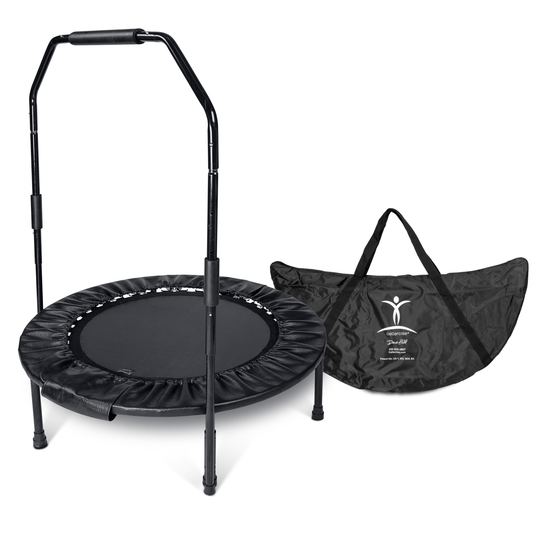Disclaimer: This Blog/Web Site is made available by the publisher for educational purposes only as well as to give general information & understanding regarding the industry. It is not to be used as specific medical advice or to replace consulting with your doctor. You should always consult with your doctor. By using this Blog / Web Site you understand that this Blog/Web Site should not be used as a substitute for medical advice from a licensed professional. For our full disclaimer, please read: http://cellercise.com/disclaimer
Health Benefits of Rebounding If You Have Diabetes
Rebounding, or using a small trampoline to exercise, exposes individuals to fluctuating gravitational forces, which stimulates the lymphatic system. Rebounding offers a variety of health benefits for people of all fitness levels, but it can be especially beneficial for those with diabetes. Learn how the body responds to rebounding and how it is especially beneficial to those with both type one and two diabetes.
Diabetes Impacts the Lymphatic System
Until recently, experts didn’t understand how diabetes affected the lymphatic system. The lymphatic system plays an important role in how the body responds to disease. Its function is to move lymph, a clear fluid made of mostly white blood cells, to the lymph nodes. The sticky fluid washes over cells throughout the body and picks up viruses, bacteria, and even cancer cells. People have lymph nodes all over their bodies, but they’re concentrated in the neck, groin, armpits, under the chin and behind the ear. When people go to the doctor with an illness, the doctor often checks lymph nodes in the throat for signs of swelling that indicate infection. Lymph nodes act like filters. They are full of immune cells that destroy germs and fight infection. They remove infected cells, then release filtered fluids back into the bloodstream. The lymphatic system sends destroyed toxins, dead cells, and metabolic waste to be flushed away in sweat, mucus, urine, and other waste products. A healthy lymphatic system is like the soaker hoses some people use to allow water to seep slowly through tiny holes into their yards. It carries dangerous cells to the lymph nodes to be destroyed and allows lymphatic fluid to seep back into the body. However, a University of Missouri-Columbia study found that for people with diabetes, lymphatic vessels are often much more porous. For people with type two diabetes, their lymphatic vessels become increasingly leaky, like a water hose that has large holes drilled in it. Fewer pathogens make it to the lymph nodes, so the lymphatic system becomes less effective at filtering out disease-causing elements. People with type two diabetes might be more likely to develop problems like atherosclerosis, obesity, and edema.
Rebounding and the Lymphatic System
One of the most important benefits of rebounding for people with diabetes is that it stimulates the lymphatic system. When an individual starts bouncing, the gravitational pull on their body fluctuates. At the top of each bounce, in that split second of weightlessness, G-forces are zero. At the bottom of the bounce, when feet sink into the trampoline, G-forces are around three times their normal strength. When individuals repeat the process over and over, the G-forces stimulate the lymphatic system. Since the most critical lymph vessels are in the legs, arms and core, vertical rebounding improves lymphatic circulation. One of your largest organs for detoxification is your skin. Sweat removes toxins filtered by your lymphatic system so they are no longer in your body. Rebounding raises your body temperature and causes you to sweat so you can remove the waste your lymphatic system filtered.
Diabetes and Neuropathy
Another problem common for people with diabetes is diabetic neuropathies. Between 60 and 70 percent of people with diabetes show some amount of neuropathy, and the risk increases with age. When diabetics have a hard time controlling their blood sugar, those elevated levels can eventually damage the nerves, causing pain, tingling, or numbness. Every organ system is vulnerable to nerve damage. The digestive tract, hands, feet, or other areas might all be affected. These factors increase an individual’s risk of diabetic neuropathy:
- Poor control of blood sugar.
- Kidney disease
- Smoking or alcohol abuse
- Being overweight
- High cholesterol
- Mechanical nerve injury like carpal tunnel syndrome
Rebounding and Neuropathy
The best way to treat neuropathy is to keep nerve damage from occurring in the first place. Patients who start an exercise program as soon as they are diagnosed and maintain a healthy body weight and blood sugar can protect themselves. However, if you already have neuropathy pain, rebounding can help manage the symptoms. If your hands and feet hurt because of diabetic neuropathy, the last thing you want to do is exercise, but it does ease symptoms. A Journal of Diabetes Complications study followed people with peripheral neuropathy for four years. When they exercised four times a week, it slowed their nerve damage. Experts recommend low-impact exercise for people with painful neuropathy or loss of sensation. Rebounding is an activity that doesn’t expose feet to risk of coming into contact with sharp objects. Since it doesn’t put stress on the legs and feet, it is often well tolerated by people with peripheral neuropathy pain. Diabetic neuropathies often cause instability. Bouncing stimulates the middle ear vestibule responsible for balance, helping people be more aware of body positioning to improve stability.
Exercise and Diabetes
For individuals with diabetes, lifestyle changes are the first line of defense. Physical activity is one of the best ways to keep diabetes in check. Exercise lowers the amount of glucose in your bloodstream, and rebounding is a great way to help manage the symptoms of diabetes. Working muscles burn glucose, even if there isn’t enough insulin in your system, so your blood sugar goes down. Avoid long-term complications like kidney disease and arteriosclerosis. Exercise also gives these health benefits:
- Weight management
- Lower blood pressure
- Stronger bones
- Improved mood and energy levels
- Stress management
Other Rebounding Exercise Benefits for Diabetes
Most adults can start with sessions that last a few minutes and get gradually longer. Here are more reasons rebounding benefits people with diabetes.
- Individuals beginning a new exercise routine can start rebounding gradually. Bouncing at mild or moderate levels allows people to burn calories and reduce blood sugar while still breathing comfortably.
- Rebounding requires no prior experience or athletic abilities. As long as individuals have clearance from their doctor, they can start with gentle bouncing and increase at a comfortable pace.
- Rebounding is accessible to people with any age or body type. Many rebounders are available with safety bars, so they’re usable to those with instability issues. People who are overweight are able to enjoy rebounding because it’s easy on the joints, skeleton, and soft tissue. Where most exercises stress the knees, ankles, and lower back, rebounding distributes weight more evenly, protecting them.
- Jumping on a trampoline reduces physical stress, and the light hearted aerobic activity stimulates mood. It may reduce the depression that often occurs along with diabetes.
- Rebounding can strengthen the heart even more than running. When tested, trampoline exercise showed greater aerobic benefits than equivalent levels of running. G-force changes encourage cells to have greater oxygen uptake, improving pulmonary function.
- Rebounding improves strength, muscle tone, and proprioception – the ability to sense the body’s orientation. It can help athletes reduce the risk of injury and decrease the risk of falling for people who are elderly.
What do Diabetics Say?
People with diabetes say rebounding significantly impacts their ability to manage their blood sugar. One man says he used rebounding daily to have near perfect blood sugar results every time, with no other forms of exercise. Another woman says she worked up to 15 minutes a day, five days a week, and that she loves that she can use her rebounder even in bad weather. One couple used their rebounder to experience lower blood sugar and better sleep. In just ten minutes, diabetics improve their fitness levels, reduce blood sugar, and give themselves hope for a healthy future. Check out how a Cellerciser® can help manage your diabetes today.
NOTE: Remember to always consult with your doctor or health professional before starting new exercise routines.
Get Your Cellerciser® and start rebounding today!









